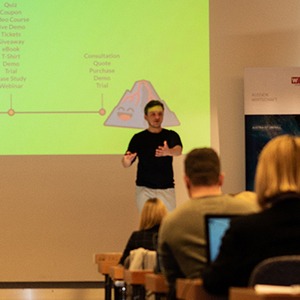What is SaaS Reporting?
SaaS reporting is a way of collecting, analyzing, presenting, and storing information within a software-as-a-service company. It allows SaaS businesses to gain insight into their revenue growth and helps to make informed decisions to optimize it. By analyzing key performance metrics from marketing and sales funnels, SaaS companies can effectively manage and improve their financial situation.
With the help of SaaS reporting, marketers, management, investors, and other stakeholders understand how well their marketing strategies contribute to the company’s overall success. SaaS reports assist in drawing conclusions about what marketing activities should be changed, why, and in what way.
Why is SaaS Reporting important?
There are many reasons why SaaS reporting is necessary. First of all, it allows you to see the current state of your business and its activities. By conducting SaaS reporting, you can learn if your marketing strategies are working and if you’re making as much profit as you should.
This, in turn, helps to wisely allocate your marketing budget and keep the costs down in the future.
With SaaS reports, you can predict your company’s long-term revenue growth and potentially improve overall business outcomes. Access to predictive analytics through reporting tools can empower your company to forecast market trends and adjust strategies. You can foresee revenue and churn for each customer segment, allowing proactive measures to be taken in case of unexpected situations. Additionally, you can determine your business’s low and high seasons and identify the causes of such seasonal performance changes.
Knowing your target audience is crucial for effectively reaching potential customers. SaaS analytics can provide insight into where customers originate and which segments convert well. This information allows for more efficient targeting of the appropriate segments in the most likely locations for finding them.
Segmenting customers by industry, LTV, and churn rate can provide a deeper understanding of user behavior, allowing for the optimization of customer experience. Identifying customers with the highest LTV can help to reveal why these customers keep using your SaaS product, whereas personalization based on segmentation can increase customer loyalty. Marketers can use this information to tailor brand messaging and product features to attract similar customer profiles and ensure long-term success.
Related: Learn more about the Growth Metrics every SaaS should track
7 Key Metrics for SaaS Reporting
Understanding the key metrics for SaaS reporting helps you decide what data to focus on and use to the advantage of your business. Here are the key metrics you should definitely include in your reports.
ARPU
ARPU, or Average Revenue Per User, refers to the revenue generated from each customer during a specific period (typically a month or year). It is calculated by taking the total revenue and dividing it by the average number of users during a specific period. This metric is important for businesses as it helps them understand their growth potential on a per-customer level and predict revenue generation capacity. It is particularly crucial for subscription-based SaaS businesses.
MRR
MRR stands for the Monthly Recurring Revenue of the business. It is a financial metric that represents the amount of money a business receives on a monthly basis from recurring sources such as subscriptions, contracts, and billing cycles. It typically excludes one-time and variable fees; however, for month-to-month businesses, it may include them.
Monitoring your MRR is essential to track the growth of your business and identify the sources of your income. A consistent increase in MRR indicates that your business model is effective and your pricing strategies align with customer needs.
ARR
ARR, or Annual Recurring Revenue, refers to the amount of money a company receives on a yearly basis from recurring sources. ARR is also the annualized version of monthly recurring revenue (MRR), representing revenue in the calendar year. It is a key metric used to track the growth of SaaS and subscription-based companies that rely on a recurring revenue model.
Conversion rate
The conversion rate is a metric that indicates the effectiveness of your website by showing the proportion of visitors who took a specific action, such as filling out a form or making a purchase, out of the total number of visitors to the site. In SaaS, the conversion rate is usually associated with the free trial conversion rate because many customers start using your product on a free trial before becoming actual customers.
When searching for benchmark figures for free trial conversion rates, it’s important to note that the numbers may vary depending on the type of trial being used. When evaluating your own free trial conversion rate, it’s more useful to compare it to your own past performance and strive to improve it rather than benchmarking it against external figures.
Churn rate
Churn rate is a metric that shows the proportion of customers who cancel or stop using a company’s service over a certain period of time divided by the total number of remaining customers.
The churn rate is one of the most important KPIs for SaaS companies. A high churn rate is an indicator of potential issues within a business and should be closely monitored. It can indicate a problem with the customer retention strategy, ineffective pricing, overcomplicated UI, or other issues. By identifying and addressing the root cause, the churn rate can serve as a metric for measuring the effectiveness of the solution.
CAC
The customer acquisition cost (CAC) refers to the money you spend to gain customers. It shows the total cost spent on marketing and sales. To calculate your CAC, add your sales and marketing expenses for a given period and divide them by the number of customers acquired in that period.
Your business can only be successful if you make more per customer than you pay to acquire them. Calculating your CAC is essential because it shows your current point of spending. It helps you set benchmarks for future budgeting and allows you to set goals to improve. Maintaining your company’s growth will be difficult if your CAC is too high.
LTV
LTV refers to the lifetime value of your customers. This metric shows how much a customer spends on your business from when they sign up to the point when they cancel their subscription. A successful business will have each customer spend many times more than it took to acquire them. The higher the LTV of a customer, the higher the revenue generated.
Conclusion
SaaS reporting helps you generate information that can change the tide of your overall business. Each key metric for SaaS companies mentioned throughout this article is relevant to having a successful SaaS report. They should be highlighted in your SaaS reporting to show where your company excelled and where it needs to improve.



